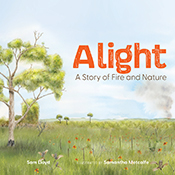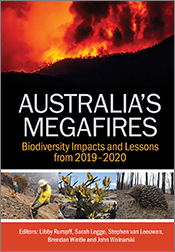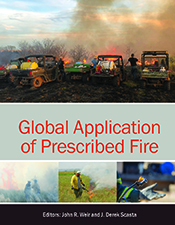Mountain Ash
Fire, Logging and the Future of Victoria's Giant Forests
By: David Lindenmayer, David Blair, Lachlan McBurney, Sam BanksEcological forest recovery in the Mountain Ash forests of the Central Highlands of Victoria following the February 2009 wildfires.
Mountain Ash draws together exciting new findings on the effects of fire and on post-fire ecological dynamics following the 2009 wildfires in the Mountain Ash forests of the Central Highlands of Victoria. The book integrates data on forests, carbon, fire dynamics and other factors, building on 6 years of high-quality, multi-faceted research coupled with 25 years of pre-fire insights. + Full description
Topics include: the unexpected effects of fires of varying severity on populations of large old trees and their implications for the dynamics of forest ecosystems; relationships between forest structure, condition and age and their impacts on fire severity; relationships between logging and fire severity; the unexpectedly low level of carbon stock losses from burned forests, including those burned at very high severity; impacts of fire at the site and landscape levels on arboreal marsupials; persistence of small mammals and birds on burned sites, including areas subject to high-severity fire, and its implications for understanding how species in this group exhibit post-fire recovery patterns.
With spectacular images of the post-fire environment, Mountain Ash will be an important reference for scientists and students with interests in biodiversity, forests and fire.
- Short descriptionNews
This title is no longer available in print format, but can still be purchased as an eBook.
Reviews
"Mountain Ash is concise and engagingly written as it presents the results of the post-fire ecological recovery research in the forests. The text is accompanied by superb clear photos and informative captions... An outstanding publication!"
Evelyn Feller, Park Watch, Issue 263, December 2015, pp 37
"I would recommend it alone for the photographic record it provides of a stunning ecosystem recovering from what is a – hopefully – once-in-a-lifetime disturbance event."
Thomas A. Fairman, Austral Ecology 42(8), December 2017
Details
ePDF | November 2015ISBN: 9781486304981
Publisher: CSIRO Publishing
Available from eRetailers
ePUB | November 2015
ISBN: 9781486304998
Publisher: CSIRO Publishing
Available from eRetailers
Features
- New and novel perspectives on the effects of fire and post-fire ecological dynamics
- Integration of data on forests, carbon, fire dynamics and other factors that have been brought together in an exciting way that builds on 6 years of high-quality, multi-faceted research coupled with 25 years of pre-fire insights
- Spectacular images of the post-fire environment
Contents
1. GENERAL INTRODUCTIONHow this book was written
The structure of the book
Background scientific articles
Common and scientific names
Caveats
2. THE 2009 BLACK SATURDAY FIRES.
Introduction
Key questions
The importance of commencing work immediately after fire
Fire severity and past disturbance history
Landscape traps
Extra work to be done and knowledge gaps to be filled
Lessons learned and management implications
3. THE FOREST AND ITS PLANTS
Introduction
The flora of montane ash forests
Key questions
When is a tree ‘mature’ and when does it develop hollows?
Historical perspectives on old growth forest
Post-fire regeneration of montane ash forest
The response of mosses and lichens to fire
The effects of fire, logging and salvage logging on tree ferns
Extra work to be done and knowledge gaps to be filled
Lessons learned and management implications
4. LARGE OLD TREES AND THE 2009 FIRES
Introduction
Key questions
Fire, drought and populations of large old hollow-bearing trees
Projections of the future abundance of large old hollow-bearing trees
Large old hollow-bearing trees and the status of old growth forest
Extra work to be done and knowledge gaps to be filled.
Lessons learned and management implications
5. CARBON STOCKS
Introduction
Key questions
Carbon stocks in montane ash forests
The effects of wildfire on carbon stocks
Forest carbon stocks and logging
Extra work to be done and knowledge gaps to be filled
Lessons learned and management implications – carbon emissions abatement, logging operations and plantation timber
6. THE RESPONSE OF POSSUMS AND GLIDERS TO FIRE
Introduction
Key questions
Fire and arboreal marsupials
Fire refugia and arboreal marsupials
The special case of fire and the Mountain Brushtail Possum
Population Viability Analysis – assessing the effectiveness of the reserve system for Leadbeater’s Possum
Extra work to be done and knowledge gaps to be filled
Lessons learned and management implications
7. SMALL TERRESTRIAL MAMMALS
Introduction
Key questions
Post-fire recovery in small terrestrial mammals
Extra work to be done and knowledge gaps to be filled
Lessons learned and management implications
8. THE RESPONSE OF BIRDS TO FIRE
Introduction
Key questions
Fire effects on birds in montane ash forests
The effects of prior occurrence on post-fire occurrence
Extra work to be done and knowledge gaps to be filled
Lessons learned and management implications
9. THE RESPONSE OF INVERTEBRATES TO FIRE
Introduction
Key questions
The responses of beetles to fire
Extra work to be done and knowledge gaps to be filled
Lessons learned and management implications
10. MANAGING A POST-FIRE FOREST LANDSCAPE
Introduction
Forest restoration strategies
Key objective 1 – Conserve existing important structures, habitats and other key areas
Key objective 2 – Restore and expand populations of key species and key structures, restore patterns of old growth landscape cover and restore key ecosystem processes
Key objective 3 – Restore key ecosystem processes
An expanded National Park as a key part of forest restoration in montane ash forests
Positive interactions and co-benefits of a suite of forest restoration strategies
Priority actions
Altered logging regimes as part of forest restoration
Extra work to be done and knowledge gaps to be filled
Concluding remarks
11. THE FUTURE
Introduction
The critical value of long-term research and monitoring
The importance of forest reform
Montane ash forests and climate change
An alternative vision for montane ash forests
The importance of ongoing monitoring and its link to environmental accounts
Future work
Concluding remarks
References
APPENDIX – Common and scientific names of species mentioned in this book
Index
Authors
David Lindenmayer is a Research Professor at The Australian National University. He has worked on forests, wildlife and fire projects for more than 30 years, and published more than 960 scientific articles and 38 books on these and other topics. He is widely regarded as one of the world’s leading ecologists and conservation scientists. He has received numerous awards and is a member of the Australian Academy of Science, an Australian Research Council Laureate Fellow and an Officer of the Order of Australia.
David Blair is a senior research officer at the Fenner School of Environment and Society, The Australian National University. Following completion of his degree in Forest Science from the University of Melbourne, he worked as a professional photographer, photographing endangered species in Indonesia and threatened environments around Australia. He then worked as an environmental consultant specialising in native and invasive vegetation and fire management before commencing with the Fenner School after Black Saturday.
Lachlan McBurney is a senior research officer at the Fenner School of Environment and Society, The Australian National University. He graduated in 2001 from Deakin University with a Bachelor of Environmental Science. He has worked for the Fenner School since 2001, co-managing the Victorian Long Term Monitoring Program in the Central Highlands.
Sam Banks is an ARC Future Fellow at the Fenner School of Environment and Society, The Australian National University. He has conducted research on the ecology, genetics and conservation of many Australian animals, from sea urchins in southern coastal waters to native rodents in the Kimberley. He has a particular passion for the biology and conservation of Australian native marsupials, particularly those of the wonderful tall eucalypt forests of south-eastern Australia.
With contributions from Philip Barton, Laurence Berry, Wade Blanchard, Emma Burns, Mason Crane, Ross Cunningham, Dan Florance, Phil Gibbons, Heather Keith, Peter Lane, Christopher MacGregor, Damian Michael, Sachiko Okada, Thea O’Loughlin, Emma Pharo, Stephanie Pulsford, Annabel Smith, John Stein, Nici Sweaney and Jeff Wood.








